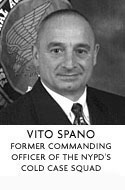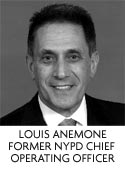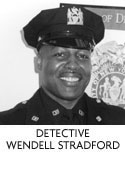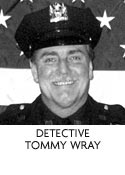Ten days before Christmas in 1996 a six-year-old boy calls 911. We don’t know how long it takes him to work up the nerve to call, but it’s just before eight o’clock at night. Speaking clearly, he tells the 911 operator, “You know, my father died.” “What?” she asks. And he repeats, “My father died.” The operator is all business. “What is your address?” When he tells her, the operator doesn’t immediately respond. “Okay?” he asks, to prompt her. “I’m just trying to verify the address,” she answers. “Where’s your mother?” “Died. Died. I’m here on my own. My father and my mother died. Somebody killed my mother and my daddy.” In the background, his two younger brothers don’t even sound human. They make noises like animals grunting. It’s an ugly sound, ugly because it’s so not right. Then, it sounds like they are roaring. Finally, their voices resolve into something more human, and they sound like children again, children wailing and crying. Apparently, these are the sounds young children make when they come upon the remains of their tortured and murdered parents. The 911 operator asks the boy what apartment he’s in and how old he is, and he gets progressively more upset. He thinks she doesn’t understand the problem. “My mother and my daddy died,” he tells her again. And then he begs, “Please help me, okay?” The first officers on the scene find the boys in their underwear climbing over the bodies.
Linda Leon, twenty-three years old, and Esteban Martinez, twenty-nine years old, were tortured, then shot in the head while their three children listened from the next room. The kids were meant to die too, it was later learned, but the girlfriend of one of the killers argued “you got what you want, let’s just get out of here” and the kids were left alone to cry. Leon and Martinez were drug dealers. So who cares, right? Pathetic lives, pathetic deaths.
Linda and Esteban were doomed. Limited by circumstance, talent, imagination, and character, dealing drugs was the best they could manage. They weren’t going to get to do something fun or worthwhile in life. Instead they would live soul-destroying lives and die, scared, after being stabbed in the ear with a Sheetrock saw for perhaps an hour, according to the police estimate, before being shot, while the only things in the world they cared for listened to every word, every scream, every plea for their lives, reduced to animal noises. The wretched killing the wretched, the case goes “cold,” who gives a fuck?
###
Since 1985, in New York City alone, the killers of 8,894 people remain free. That’s 8,894 murderers among us. Even if you want to say some of these murders were committed by the same people, as if attributing the crimes to serial killers were a better way of looking at this, that’s still a lot of murderers walking around who get to go see the new Steven Spielberg movie, eat their favorite dinner, and have sex. What could be uglier than a murderer transported by pleasure, living years and years and years, sometimes long enough to make it until a nice, relaxed old age?
Unsolved homicide cases are never closed, but some can go cold if enough evidence can’t be found to convict anyone. Sometimes detectives find themselves overrun with murder. Whenever someone is killed in their precinct they have to drop what they’re doing to investigate. The cases they were working on get pushed farther and farther back, some all the way into oblivion. And the fact is, most murder victims are people the general public cares little about. Middle-class people, people with lots of friends who never break any laws, famous people, wealthy people, sure, they’re stabbed to death from time to time, but chances are you haven’t heard of a single one of the 8,894. They had so little going for them to begin with, and now this. They’ve become nothing more than a cast-off case.
In the New York Police Department there’s a unit called the Cold Case and Apprehension Squad. While the rest of the world has forgotten the cases that have gone cold, if they ever even noticed them in the first place, the Cold Case Squad reaches into our worst past and yanks these victims back from oblivion. Who were they? What happened to them? Who did this to them? Someone deliberately, knowingly took away whatever time in life they had left. They’re supposed to answer for that. For the families who figure the world isn’t going to give their son, daughter, husband, or wife another thought, the Cold Case Squad is their one shot to correct a terrible imbalance, however inadequately.
Cases find their way to the Cold Case Squad through a number of different channels. Sometimes the commanding officer is told, “Do something with this,” when someone sends a letter to the mayor, or the police commissioner, or some other important person. A couple of years ago, the sister of a man who was killed with a meat cleaver in 1971 wrote, “This is the 28th year of this heinous crime and the injustice was terrible then and to this day is still quite overbearing. Are you still working on this case? Or have you decided that since 28 years have past [sic], we may as well let another murderer walk away free?” The Cold Case Squad soon discovered that her brother’s killer had already been dead ten years when she mailed that letter. He died of smoke inhalation from a kitchen fire in his tiny, squalid one-bedroom apartment in Philadelphia. After three decades of waiting, it was a very unsatisfying ending for the victim’s sister. She was sorry he didn’t burn alive.
A record of every murder in New York, solved or unsolved, is kept at the Homicide Analysis Unit at 1PP, in homicide logbooks. (Police headquarters is always referred to as 1PP, short for One Police Plaza, the address for NYPD headquarters. It’s pronounced OnePeePee. For months I’d look up to see if the grown man or woman saying OnePeePee was saying it with a straight face. Another name for OnePeePee: “the Puzzle Palace,” except the people who work there don’t like that name, so no one uses it to their face.)
The oldest remaining logbook in the NYPD’s possession is from 1964. There were 697 homicides listed that year. Of the 697, 122 cases are cold. We’ll probably never learn who killed 122 men, women, and babies that year. Most of these victims were stabbed. After that, they were killed by guns and cars. Fists and feet are listed as weapons in 21 cases. In 1964, abortions were officially considered homicides, and there were 12 of them in the logbook, including one “charred fetus.” One person was killed by a pumpkin (no explanation was given). Other unusual weapons listed are a television stand, a bar stool, acid, a beer can opener, a candle. On October 6 of that year, in the 73 Precinct, Anni Malzen died of wounds made by a sledgehammer. (Detectives don’t say the “73rd” Precinct, they say the “seven three” Precinct. The “one two oh” Precinct, not the “120th.” This is true for all the precincts above the 19th.) And while an arrest was made, someone later added, in parentheses, “suicide.” How do you kill yourself with a sledgehammer?
Murders committed from 1985 on are now entered into an electronic database, but every entry from 1964 to the present bears exactly the same information: entry number, date of homicide, precinct number, name of victim, type of weapon, and whether an arrest has been made. That’s it. A detective can’t tell just by looking at these records if there is anything he can solve.
Sometimes the squad commanders themselves go out to the precincts and bring back a case. Perhaps they got a phone call from an old friend, “I got a tip about this case…,” or there’s a case from their younger days in another precinct that they never quite forgot.
Every time the Cold Case Squad solves a case and it hits the local papers, they get calls about other murders and sometime manage to pick up a few leads. Now they get e-mail, too. Tips can come from anywhere.
Last May, a forty-four-year-old Queens man named Eddie Delmage called Opie & Anthony, a Howard Stern-like radio show that was on WNEW at the time, and confessed to the 1977 murder of two Colombian drug dealers during a segment called “Total Truth Tuesday.” Eddie said he shot them during a drug deal, burned the bodies, then threw what was left away in the meat-packing district by the river in Manhattan. He was calling Opie & Anthony, he said, to offer his place to a homeless woman known on the show as Stalker Patty. He wanted to make up for his past mistake. “He didn’t sound like the kind of guy to make this up,” cohost Anthony Cumia said. Detectives from the squad couldn’t find a case fitting his description, but they had to look into it nonetheless.
Anthony was wrong. Eddie was making it up. When detectives arrived to investigate he answered the door to his dark apartment in nothing but an undershirt and slippers. “I asked, would he like to get dressed before we start talking,” Deputy Inspector Vito Spano, the commanding officer of the Cold Case Squad, said, “because he really wasn’t a pretty sight standing there.” Eddie was nervous. “It felt like a sad house that time had passed,” Spano continued. “Something had happened here and Eddie was too devastated to pick up the pieces. Things were out of place or left out, not put away, a heavy dust over everything. He was like a man still waiting for his wife to come home.” These are the glimpses the detectives get into our lives. “It wasn’t nice to look at,” Vito told me. “I felt depressed.” Eddie had worked for a cargo-handling company at the airport, but he’d been on disability for the past twelve years. Eddie felt that Opie and Anthony hadn’t appreciated his generous offer to Stalker Patty, and he took it as an insult to his manhood. The phony confession was a desperate shot at building himself up. He wanted to be the romantic, dangerous but reformed killer, looking for redemption by rescuing the damsel in distress, not the pale, paunchy, middle-aged man living downstairs from his mother, abandoned by life, who, if he had ever had any dramatic moments in his life, had few left now. “Defending his manhood” is a recurring theme in Cold Case Squad investigations.
More often, though, cold cases are picked up and brought back by detectives themselves. They say “I’m assuming a case” or, simply, “I’m working the case.” There’s also the more crude but popular “This is my bag of shit.” The detectives have their own contacts and informants, their own resources, and their own ambitions. Sometimes they read about a case in the newspaper and think, Okay, they did this, but I would have done that. Assuming someone else’s case can be a delicate matter, but not always.
When someone is murdered, the case belongs to the Homicide Squad in the precinct where the body is found. Back in the eighties and early nineties, when there were more than two thousand murders a year in the city, no one wanted to pick up yet another homicide in their precinct, especially if it looked like it was going to be “a loser,” what they call cases that are difficult to solve. Precinct commanders literally fought over which side of the precinct lines a body fell. Spano remembers a 1987 murder committed in the 83 Precinct. The killer moved the body and it sat for a week in a Dumpster in the 72 Precinct, where at the time Vito Spano was a young and less experienced Detective Squad commander. Then the body was carted off, along with the trash, to the 94 Precinct. Thinking the case was a loser, the 94 Precinct Detective Squad commander, who was older and meaner, called Spano and made him take it, even though by rights the homicide should have been the 94’s. Mistake. Spano’s squad solved the case two days later. Fingerprints were lifted off the linoleum the body was wrapped in, and when Vito and his detectives went to the address listed on the suspect’s record and peeked inside, there on the floor, with a large piece missing, was the same linoleum.
Assuming someone else’s case once they’ve put some effort into it, however, is something else. You’re saying, “I think I can solve the case you couldn’t.” The initial reaction is often “You think you’re going to show me up? Piss off.” Technically, if the precinct detective isn’t actively working the case, the Cold Case Squad detective can simply say, “Fuck you. Give me the case.” If the precinct detective balks, Vito can call the squad boss at the precinct, and now it’s Vito’s delicate matter. But no one wants the running-back-to-daddy stigma of that. And there are other reasons the cold case detectives would prefer to handle it themselves than go to Vito. People get transferred, special units are dissolved. The guy you screwed carelessly today could be your boss or partner tomorrow. The smartest detectives use a little diplomacy and make the precinct detective comfortable with handing over the case: “You’ve got all these other cases, and I have a little time on my hands, would you mind if I take a look?” Once the case is formally signed out with the Cold Case Squad it’s got the Cold Case Squad detective’s name on it. He’s responsible now. The precinct detective is off the hook. The case is logged into the Cold Case Squad’s database and given a brand-new case number. If it’s never solved, now it’s because the Cold Case Squad couldn’t solve it.
###
There are three reasons a case goes cold. Either they couldn’t solve it (no evidence or witnesses), they didn’t want to solve it, or someone screwed up.
Order The Restless Sleep: Inside New York City’s Cold Case Squad .











